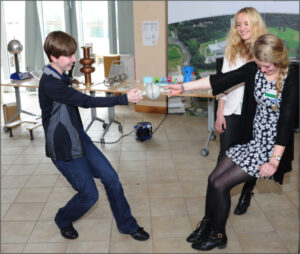
Students discover the ‘power of vacuum’ using a pair of Magdeburg Spheres[2] , supervised by Penny Jones of Withington Girls School 6th form (‘graduate’ of the 2014 Masterclass)
The Masterclass was opened by Dr. Graeme Burt, from Lancaster University and the Cockcroft Institute, who gave a historic review of the Daresbury Laboratory, and showed the many applications of accelerator and particle physics beyond the search of new particles, including creating better chocolate and making shrink wrap. Prof. Fred Loebinger then gave his ever-popular overview of Particle Physics, and the part played by the University of Manchester.
Following refreshments the students embarked on a series of practical, hand-on activities. These activities comprised an experiment to estimate the electron beam energy in the ALICE injector line, accelerator physics and particle physics simulations, and a series of thought-provoking demonstrations of physics and certain key under-pinning technologies required for many particle accelerators.
In previous years, the ALICE beam experiment has been carried out at the accelerator itself, with students able to see the accelerator and make the requisite measurements, but sadly, requirements of the ALICE operational programme dictated that access for the Masterclass would not be possible this year. Instead, the students completed this as a classroom exercise, supported by a demonstration of an electron beam bending in a magnetic field using a fine-beam tube and a webcam. Under expert guidance from CI staff and Ph.D. students, the visiting students were able to complete the calculation and estimate the energy of this relativistic electron beam.
One of the tasks set for the students was completion of the Lancaster Particle Physics Package – a web-based package which reviews the basic principles of physics and particle physics, and goes on to apply these to real LHC collision data. Ultimately, the students are able to identify collisions which contain the signature of a Higgs particle. This activity was complemented with accelerator physics simulations using the MAD package to investigate the effects of varying magnet strengths in the accelerator lattice on the focussed beam size at the collision (interaction) points in the LHC.
Aspects of under-pinning particle accelerator technology such as vacuum, superconductivity, the use of high voltage to accelerate particles and the use of magnetic fields were also demonstrated to students in what was the most relaxing of the four practical sessions. In this session the students got hands-on experience of vacuum and its effects as well as seeing real accelerator components. Students and teachers alike were amazed by the Meissner effect[1] in which a high-temperature superconductor is first seen to levitate above a magnetic track, and then ‘hang’ from the inverted magnetic track (it literally levitates below the magnetic track). A viewing of the ALICE promotional video completed this activity, and gave the students a clear picture of how the free-electron laser light and THz radiation generated by ALICE is used for scientific research.
A generous buffet lunch was laid on, and while students discussed the morning’s activities or checked their facebook account, their teachers discussed science and outreach opportunities with the ASTeC and CI staff present. The students were also given the opportunity during the lunch break to view a presentation prepared by the University of Manchester on the GridPP network for the processing of LHC and particle physics data.
The day was rounded-off with talks by Prof. Tim Greenshaw on the University of Liverpool’s work in the field astroparticle physics. Throughout the day students were answering a series of quiz questions and the prizes were awarded at the end of the day.
Feedback during and after the event has been superb, as the following quotes demonstrate:
“All of our 6th formers really enjoyed the day and it made them feel a part of the Science community. Both myself and the physics team thought the day was fantastic and very inspiring. It was also very relevant to their exam specification which is great.” – Laura Whittaker, Outwood Grange Academy
“It was the best school trip that I have attended to-date” – anon
“I just wanted to say a massive thank you to you and all the people that helped with the workshop. It was so professionally organised and also was so helpful to the AS course. The feedback from our pupils on the coach back was great and they would all like to thank you and the organisation team.” – Lee Suthard, Altrincham Grammar School for Boys
Graeme Burt, from the Cockcroft Institute said:
“The STFC team did a great job in organising this year’s masterclass and always enjoy taking part. It’s a great opportunity to connect with the next generation of particle physicists and engineers and help nurture their passion. I am always surprised by how much the students already know about particle physics, and sometimes we have to look up some of the students more advanced answers to the quiz.”
[1] The expulsion of a magnetic field from a superconductor – http://en.wikipedia.org/wiki/Meissner_effect
[2] A pair of hemispheres with mating rims used to demonstrate the power of atmospheric pressure http://en.wikipedia.org/wiki/Magdeburg_hemispheres
Contacts:
Dr. Lee Jones – ASTeC and Cockcroft Institute outreach & public engagement
Wendy Cotterill – Daresbury Laboratory public engagement officer
